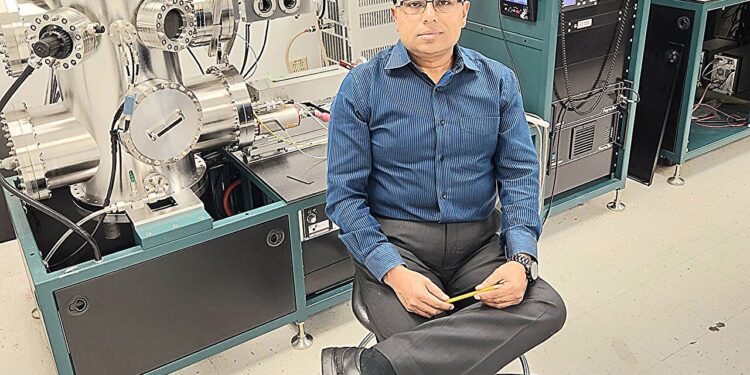UCF researcher Debashis Chanda is an expert in infrared imaging. Credit: University of Central Florida
Debashis Chanda, a researcher at the University of Central Florida and professor at the NanoScience Technology Center, has developed a new technique for detecting photons, elementary particles that range from visible light to radio frequencies and play a key role in cellular communication .
These advances could lead to more precise and efficient technologies in a variety of areas, from improving medical imaging and communications systems to improving scientific research and even potentially strengthening security measures.
Photon detection generally relies on changing/modulating voltage or current amplitude. But Chanda developed a way to detect photons by modulating the frequency of an oscillating circuit, paving the way for ultra-sensitive detection of photons.
Chanda’s method uses a special phase change material (PCM) that changes shape when light hits it, creating an electrical rhythm that remains stable or a stable oscillation of the electrical circuit. When a photon of light hits the material, it changes the speed of the rhythm or changes the frequency of oscillation. The amount of rhythm changes depends on the intensity of the light, in the same way that a person’s voice changes the sound of the radio.
The new development was recently published in Advanced functional materials.
Long-wave infrared (LWIR) detection in the wavelength range of 8 to 12 micrometers is extremely important in astronomy, climatology, materials analysis and security. However, LWIR detection at room temperature has been a long-standing challenge due to the low photon energy.
Currently available LWIR detectors can be broadly classified into two types: cooled and uncooled detectors, both of which have their own limitations.
Although cooled detectors provide excellent detectivity, they require cryogenic cooling, which makes them expensive and limits their practical usefulness. On the other hand, uncooled detectors can operate at room temperature but suffer from low detectivity and slow response due to the higher thermal noise intrinsic to room temperature operation. A fast, highly sensitive, and inexpensive infrared detector/camera continues to face scientific and technological challenges.
This is the main reason why LWIR cameras are not widely used except in Department of Defense and space-specific applications.
“Unlike all current photon detection schemes in which light power modifies the amplitude of the voltage or current (amplitude modulation – AM), in the proposed scheme, photon impacts or incidents modulate the frequency of “an oscillating circuit and are detected as a frequency shift. providing inherent robustness to noises, which are AM in nature,” explains Chanda.
“Our FM-based approach produces exceptional power, response time and detectivity in terms of room temperature noise,” explains Chanda. “This general concept of FM-based photon detection can be implemented in any spectral range based on other phase-changing materials.”
“Our results present this new FM-based detector as a unique platform for creating low-cost, high-efficiency uncooled infrared detectors and imaging systems for various applications such as remote sensing, thermal imaging and medical diagnoses,” says Chanda. “We are convinced that performance can be further improved through appropriate packaging on an industrial scale. »
This concept developed by the Chanda group brings a paradigm shift towards uncooled and very sensitive LWIR detection, because noise limits detection sensitivity. This result promises a new uncooled LWIR detection scheme that is highly sensitive, inexpensive, and can be easily integrated into electronic readout circuits, without requiring complex hybridization.
More information:
Tianyi Guo et al, Long-wave infrared detection and imaging based on room temperature frequency modulation, Advanced functional materials (2023). DOI: 10.1002/adfm.202309298
Provided by University of Central Florida
Quote: A researcher discovers a new photon detection technique (December 12, 2023) retrieved on December 13, 2023 from
This document is subject to copyright. Apart from fair use for private study or research purposes, no part may be reproduced without written permission. The content is provided for information only.



